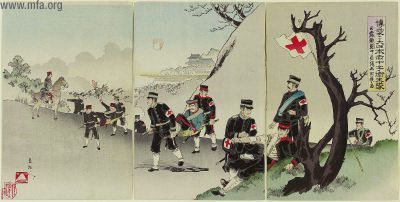Professor Akira Iriye gave a talk at the Reischauer Institute yesterday which, like most Japan Forum events, was open to the public. Iriye has been attending various conferences in this year of dual anniversaries for the end of the Russo-Japanese war and World War II and has been collecting impressions and insights that he shared with the audience yesterday. He divided his comments by looking at the two postwars from the perspective of the individual, its impact on the region, and broadly in terms of 20th century history.
On the individual level he focused on the experience of Asakawa, Kan’ichi (1873-1948), who like Iriye, was a professor in the United States, and spent over 50 years in the United States. Apparently, as of this year, Iriye will have been in the country longer than Asakawa. Iriye contrasted the experience of Asakawa, who found himself frequently in an awkward position of having to balance and moderate between often extreme opinions on the Japanese and US side, with his own life in the United States, which he says shared none of these difficulties.
In what was perhaps the most interested aspect of the talk Iriye discussed his own diary, which he started August 19, 1945, only days after the end of the war. At the time, he notes, he was apparently moderately nationalistic and felt awful about Japan’s defeat (his entries until the 26th, however, were dominated by discussion of how he managed to obtain food for that day). He posed an open question to the audience about how one makes a transition from such nationalistic views to a more internationalist perspective. He made such a change himself, describing himself now as anti-nationalist and internationalist, and suggests that in his particular case it was the cosmopolitan atmosphere at American universities and the American education system which is to credit for this change. He says that however critical he may be of the United States now, this has not changed.
Later in his talk, when he made some comments on the implications for the broader 20th century Iriye made some bold predictions about the future, as he has made in previous talks and writings. If 1905 represents the true entry of Japan onto the world stage as a world power and empire, and 1945 represents the shift from a world dominated by empires to one dominated by the nation-state, Iriye sees the current trends towards an age of regional institutional forces, and especially, non-state “transnational” actors. He is strong about this claim, and believes it is “foolish” to believe that the nation-state can continue to be the primary force in the coming century. He is especially hopeful about developments towards a regional community in Asia.
Finally, Iriye noted that Japanese opinion about the two wars has always been divided, and generally fall into two camps: those who celebrate the Russo-Japanese war and lament the defeat in 1945, and those who hold the reverse position. Iriye places himself firmly in the latter camp, believing that the 1905 was “disastrous” because it led to Japanese hegemony in Korea and China. In this respect, he seems critical of approaches that view, in his words, the conflict as a “war of civilizations.” As for 1945, Iriye argues that Japan’s defeat had the effect of forcing Japan to relate to the world in terms of economics, culture, etc. thus positioning it well to face the challenges of the future.

